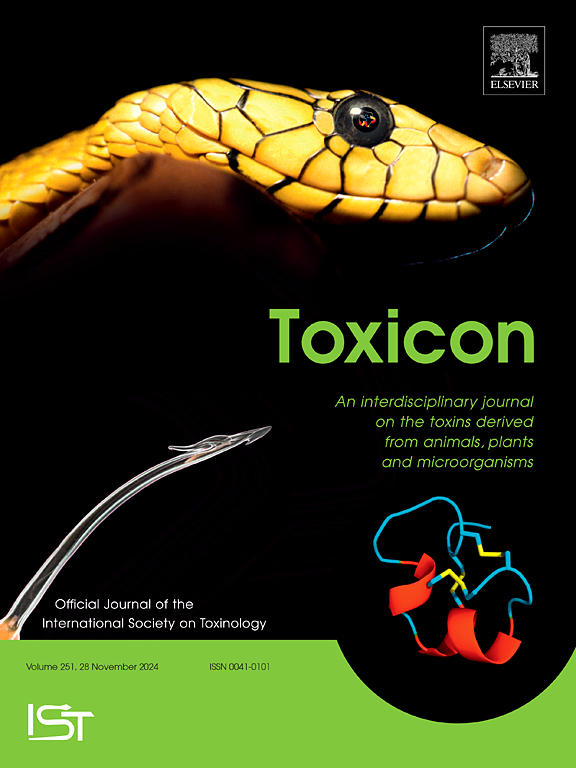苯丙酮及其结构类似物对黄颡鱼蛾(鞘翅目:拟甲科)的抗虫活性
IF 2.6
4区 医学
Q2 PHARMACOLOGY & PHARMACY
引用次数: 0
摘要
多项研究证实,杜鹃花挥发油具有良好的抗虫活性,有望成为一种环保型植物性杀虫剂,其主要有效成分为苯丙酮。苯丙酮化学结构简单,只含碳、氢、氧三种元素,毒性低,易于降解。因此,本研究选择苯丙酮及其7种结构类似物对castaneum Herbst(鞘翅目:拟粉甲科)进行抗虫活性测试,以探索苯丙酮对castaneum起作用的关键结构位点。与阳性对照拟除虫菊酯相比,苯丙酮具有更好的驱避活性,且当3、4位的单键转化为双键时,驱避率增加。苯丙酮的熏蒸活性呈浓度依赖性,显著高于阳性对照拟除虫菊酯类杀虫剂。在失去位置3和4的两个亚甲基后,LC50降至13.10 mg/L,比苯丙酮低约9.4倍。苯丙酮对castaneum的接触活性是拟除虫菊酯的2倍左右。当3、4位单键变为双键时,接触死亡率比苯丙酮高2.5倍,LD50达到10.47 μg/成虫。驱避、熏蒸和接触毒性实验结果表明,苯丙酮侧链、侧链上的羰基和未取代的苯环是其防治蓖麻子的关键结构。本研究探索了苯丙酮在castaneum抗虫活性中的构效关系,为其结构修饰提供思路。本文章由计算机程序翻译,如有差异,请以英文原文为准。

Anti-insect activity of benzylacetone and its structural analogues against Tribolium castaneum (Coleoptera: Tenebrionidae)
Several studies have confirmed that the volatile oil of Rhododendron anthopogonoides Maxim has good anti-insect activity and is expected to become an environmentally friendly botanical insecticide, with benzylacetone as its main active component. Benzylacetone has a simple chemical structure, containing only three elements of carbon, hydrogen and oxygen, low toxicity, and easy degradation. Therefore, in this study, benzylacetone and its seven structural analogues were selected for testing their anti-insect activity to Tribolium castaneum Herbst (Coleoptera: Tenebrionidae), in order to explore the key structural sites where benzylacetone plays a role in combating T. castaneum. Benzylacetone demonstrated better repellent activity compared to the positive control pyrethroid, and when the single bonds at positions 3 and 4 were transformed into double bonds, the percent repellency increased. Additionally, the fumigation activity of benzylacetone exhibited a concentration-dependent trend and was significantly higher than that of the positive control pyrethroid. After losing two methylene groups at positions 3 and 4, the LC50 decreased to 13.10 mg/L air, which was approximately 9.4 times lower than that of benzylacetone. In terms of contact activity against T. castaneum, benzylacetone was about 2 times more effective than pyrethroids. Moreover, when the single bond at positions 3 and 4 became a double bond, the contact mortality was 2.5 times higher than that of benzylacetone, and the LD50 reached 10.47 μg/adult. Based on the results of repellent, fumigation, and contact toxicity experiments, it was found that the side chains of benzylacetone, carbonyl groups on the side chains, and benzene ring unsubstituted were the key structures for its prevention and control against T. castaneum. This study is an exploration of the structure-activity relationship of benzylacetone in the anti-insect of T. castaneum, providing ideas for its structural modification.
求助全文
通过发布文献求助,成功后即可免费获取论文全文。
去求助
来源期刊

Toxicon
医学-毒理学
CiteScore
4.80
自引率
10.70%
发文量
358
审稿时长
68 days
期刊介绍:
Toxicon has an open access mirror Toxicon: X, sharing the same aims and scope, editorial team, submission system and rigorous peer review. An introductory offer Toxicon: X - full waiver of the Open Access fee.
Toxicon''s "aims and scope" are to publish:
-articles containing the results of original research on problems related to toxins derived from animals, plants and microorganisms
-papers on novel findings related to the chemical, pharmacological, toxicological, and immunological properties of natural toxins
-molecular biological studies of toxins and other genes from poisonous and venomous organisms that advance understanding of the role or function of toxins
-clinical observations on poisoning and envenoming where a new therapeutic principle has been proposed or a decidedly superior clinical result has been obtained.
-material on the use of toxins as tools in studying biological processes and material on subjects related to venom and antivenom problems.
-articles on the translational application of toxins, for example as drugs and insecticides
-epidemiological studies on envenoming or poisoning, so long as they highlight a previously unrecognised medical problem or provide insight into the prevention or medical treatment of envenoming or poisoning. Retrospective surveys of hospital records, especially those lacking species identification, will not be considered for publication. Properly designed prospective community-based surveys are strongly encouraged.
-articles describing well-known activities of venoms, such as antibacterial, anticancer, and analgesic activities of arachnid venoms, without any attempt to define the mechanism of action or purify the active component, will not be considered for publication in Toxicon.
-review articles on problems related to toxinology.
To encourage the exchange of ideas, sections of the journal may be devoted to Short Communications, Letters to the Editor and activities of the affiliated societies.
 求助内容:
求助内容: 应助结果提醒方式:
应助结果提醒方式:


